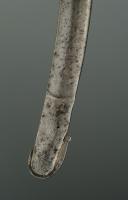
Hussar troop sabre, An IV model, Revolution (approximately from 1792 to 1802).
Sold out
Hussar Troop Saber, Model Year IV, Revolution.
Brass hilt, single-branch guard, long-tailed cap, black waxed calfskin-wrapped wooden handle. Curved blade with hollow facets, measuring 80 cm in length, 3.7 cm wide at the base, engraved on the back with "KLINGENTHAL"; on one side of the blade, on its first third, is engraved "Rpe" and on the other side "Franse"; it is stamped with a "B" topped with the Phrygian cap of the 1st class controller F. Bisch (1792-1798) and the oval stamp "MK" in a crown of pearls corresponding to the stamp of the Klingenthal manufacture (1792-1798). Wooden scabbard covered in black waxed leather with two large steel fittings with brass belt loops and steel rings. Steel blade tip. Brass cup-shaped chape.
Very good condition, some oxidation and signs of use on the scabbard.
France.
Revolution.
NOTE:
In his book "The History of Hussar Sabers from Louis XIV to the Present Day," published by Éditions du Canonnier in 2010, Michel Pétard writes, "The republican version of the 1777 saber is distinguished from its direct ancestor by its iron-mounted scabbard. No significant archives allow us to know its origins, but the examination of the markings on many specimens demonstrates production spanning from around 1792 to 1798, primarily from Klingenthal. Simultaneously, private industry productions were also very present, sometimes using blades forged at Klingenthal. Of course, the large fleur-de-lis engraved on the blade under the monarchy until 1792 was replaced by the monogram "Repe Franse" engraved on either side of the blade. The back always bears "KLINGENTHAL" engraved in bold capital letters. Saber figure 33: Klingenthal stamps between 1793 and 1798. Saber figure 34: Klingenthal stamps between 1798 and 1802."
Brass hilt, single-branch guard, long-tailed cap, black waxed calfskin-wrapped wooden handle. Curved blade with hollow facets, measuring 80 cm in length, 3.7 cm wide at the base, engraved on the back with "KLINGENTHAL"; on one side of the blade, on its first third, is engraved "Rpe" and on the other side "Franse"; it is stamped with a "B" topped with the Phrygian cap of the 1st class controller F. Bisch (1792-1798) and the oval stamp "MK" in a crown of pearls corresponding to the stamp of the Klingenthal manufacture (1792-1798). Wooden scabbard covered in black waxed leather with two large steel fittings with brass belt loops and steel rings. Steel blade tip. Brass cup-shaped chape.
Very good condition, some oxidation and signs of use on the scabbard.
France.
Revolution.
NOTE:
In his book "The History of Hussar Sabers from Louis XIV to the Present Day," published by Éditions du Canonnier in 2010, Michel Pétard writes, "The republican version of the 1777 saber is distinguished from its direct ancestor by its iron-mounted scabbard. No significant archives allow us to know its origins, but the examination of the markings on many specimens demonstrates production spanning from around 1792 to 1798, primarily from Klingenthal. Simultaneously, private industry productions were also very present, sometimes using blades forged at Klingenthal. Of course, the large fleur-de-lis engraved on the blade under the monarchy until 1792 was replaced by the monogram "Repe Franse" engraved on either side of the blade. The back always bears "KLINGENTHAL" engraved in bold capital letters. Saber figure 33: Klingenthal stamps between 1793 and 1798. Saber figure 34: Klingenthal stamps between 1798 and 1802."
Reference :
15625

Next update Friday, december 27th at 1:30 PM
FOR ALL PURCHASES, PAYMENT IN MULTIPLE CHECKS POSSIBLE
bertrand.malvaux@wanadoo.fr 06 07 75 74 63
An authenticity certificate of the item including the description published on the site, the period, the sale price, accompanied by one or more color photographs is automatically provided for any item priced over 130 euros. Below this price, each certificate is charged 5 euros.
Only items sold by me are subject to an authenticity certificate, I do not provide any expert reports for items sold by third parties (colleagues or collectors).










